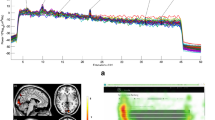Abstract
This study ranks twelve electroencephalogram (EEG) electrodes, located in the parieto-occipital and occipital regions of the human scalp, according to their relevance in the detection of steady-state visually evoked potential (SSVEP). Monopolar and bipolar arrangements were used to evaluate the capability of these electrodes to improve the signal detection performance in SSVEP-based brain-computer interfaces (BCIs). EEG signals were acquired from 18 volunteers, 8 of whom had disabilities. The signals were analyzed using four EEG signal processing methods commonly used for SSVEP-based BCIs, namely independent component analysis, lock-in analyzer system, multiple channel detection, and spectral F test. The results show that Oz is the most suitable electrode in SSVEP detection. However, further investigation should be conducted for other EEG paradigms. The five most highly suitable bipolar settings are POz-Oz, POz-O1, POz-O2, PO3-Oz, and PO4-Oz.







Similar content being viewed by others
References
Hsu, Wey-Yen. (2012). Application of prediction and multiscale synchronization to brain-computer interface. Journal of Medical and Biological Engineering, 34(2), 137–143.
Vialatte, F. B., Maurice, M., Dauwels, J., & Cichocki, A. (2010). Steady-state visually evoked potentials: Focus on essential paradigms and future perspectives. Progress in Neurobiology, 90, 418–438.
Müller, S. M. T., Celeste, W. C., Bastos-Filho, T. F., & Sarcinelli-Filho, M. (2010). Proposal of a brain-computer interface based on visual evoked potentials to command an autonomous robotic wheelchair. Journal of Medical and Biological Engineering, 30, 407–416.
Benevides, A. B., Bastos-Filho, T. F., & Sarcinelli-Filho, M. (2012). Pseudo-online classification mental tasks using Kullback–Leibler symmetric divergence. Journal of Medical and Biological Engineering, 32, 411–416.
Bastos-Filho, T. F., Ferreira, A., Atencio, A. C., Arjunan, S., & Kumar, D. (2012). Evaluation of feature extraction techniques in emotional state recognition. Proceedings of IEEE International Human Computer Interaction, 1, 1–6.
Friman, O., Volosyak, I., & Gräser, A. (2007). Multiple channel detection of steady state visual evoked potentials for brain-computer interfaces. IEEE Transactions on Biomedical Engineering, 54, 742–750.
Muller-Putz, G. R., Eder, E., Wriessnegger, S. C., & Pfurtscheller, G. (2008). Comparison of DFT and lock-in amplifier features and search for optimal electrode positions in SSVEP-based BCI. Journal of Neuroscience Methods, 168, 174–181.
Wang, Y., Zang, Z., Gao, X., & Gao, S. (2004). “Lead selection for SSVEP-based brain-computer interface. Conference Proceedings of IEEE Engineering in Medicine and Biology Society, 1, 4507–4510.
Fehmi, L. G., & Collura, T. (2007). Effects of electrode placement upon EEG biofeedback training: The monopolar-bipolar controversy. Journal of Neurotherapy, 11, 45–63.
Daly, D. D., & Pedley, T. A. (1990). Current practice of clinical electroencephalography. New York: Raven Press Ltd.
Wang, Y., Wang, R., Gao, X., Hong, B., & Gao, S. (2006). A practical VEP based brain computer interface. IEEE Transactions on Neural Systems and Rehabilitation Engineering, 14, 234–239.
Muller-Putz, G. R., Scherer, R., Brauneis, C., & Pfurtscheller, G. (2005). Steady-state visual evoked potential (SSVEP)-based communication: Impact of harmonic frequency components. Journal of Neural Engineering, 2, 123–130.
Muller-Putz, G. R., Scherer, R., Neuper, C., & Pfurtscheller, G. (2006). Steady-state somatosensory evoked potentials: Suitable brain signals for brain-computer interfaces? IEEE Transactions on Neural Systems and Rehabilitation Engineering, 14, 30–37.
Schacham, S. E., & Pratt, H. (1985). Detection and measurement of steady-state evoked potentials in real-time using a lock-in amplifier. Journal of Neurosurgery, 62, 935–938.
Scharf, L. L., & Friedlander, B. (1994). Matched subspace detectors. IEEE Transactions on Signal Processing, 42, 2146–2157.
Liavas, A. P., Moustakides, G. V., Henning, G., Psarakis, E. Z., & Husar, P. (1998). A periodogram-based method for the detection of steady-state visually evoked potentials. IEEE Transactions on Biomedical Engineering, 45, 242–248.
Davila, C., Srebro, R., & Ghaleb, I. (1998). Optimal detection of visual evoked potentials. IEEE Transactions on Biomedical Engineering, 45, 800–803.
Müller, S. M. T., Bastos, T. F., & Sarcinelli-Filho, M. (2013). Proposal of a SSVEP-BCI to command a robotic wheelchair. International Journal of Control, Automation Electrical and System, 24, 97–105.
de Sá, A. M. F. L. M., Thiengo, H. C., Antunes, I. S., & Simpson, D. M. (2009). Assessing time- and phase-locked changes in the EEG during sensory stimulation by means of spectral techniques. Proceedings of IFMBE, 25, 2136–2139.
Author information
Authors and Affiliations
Corresponding author
Rights and permissions
About this article
Cite this article
Müller, S.M.T., Bastos-Filho, T.F. & Sarcinelli-Filho, M. Monopolar and Bipolar Electrode Settings for SSVEP-Based Brain-Computer Interface. J. Med. Biol. Eng. 35, 482–491 (2015). https://doi.org/10.1007/s40846-015-0056-1
Received:
Accepted:
Published:
Issue Date:
DOI: https://doi.org/10.1007/s40846-015-0056-1




